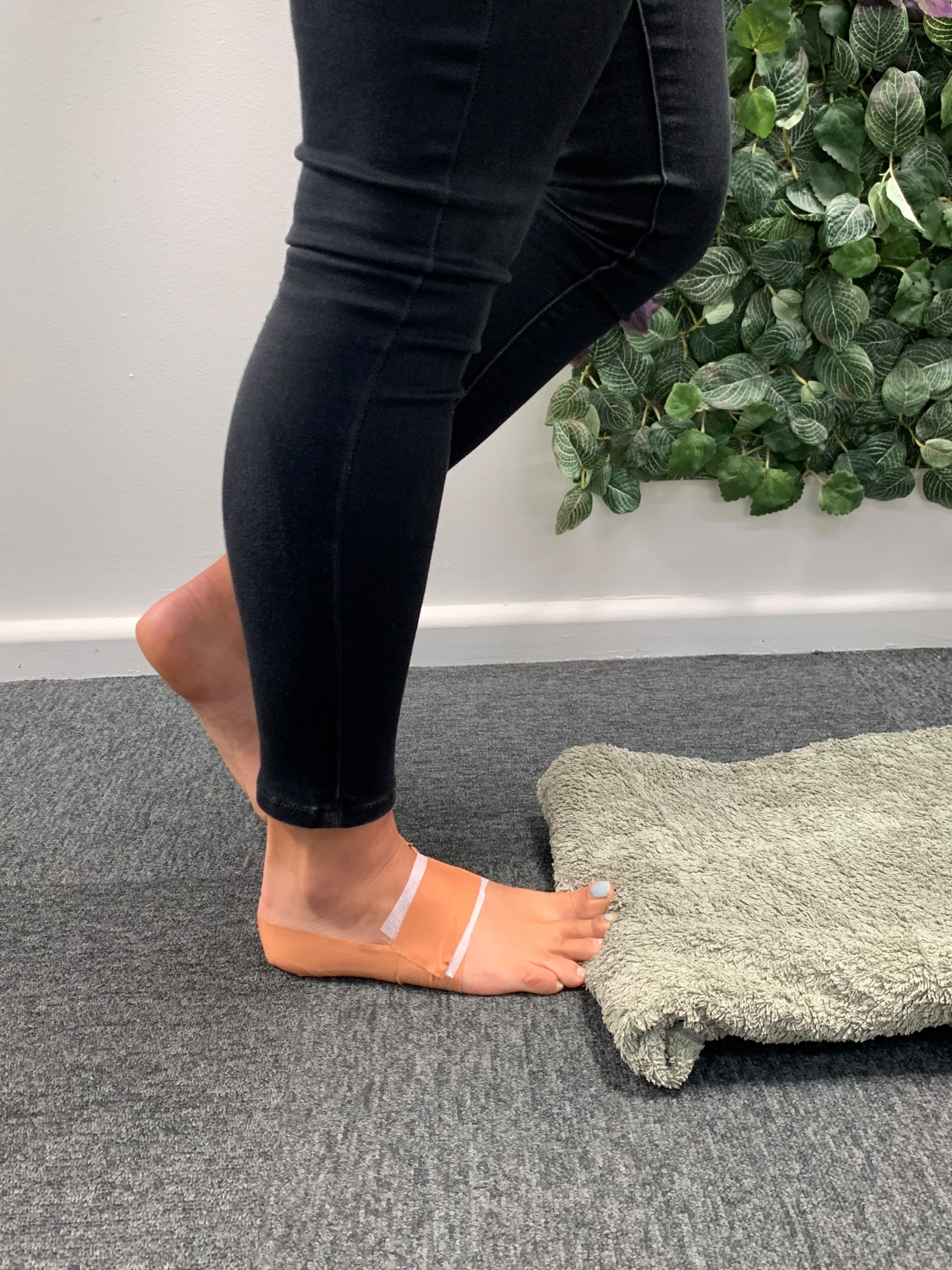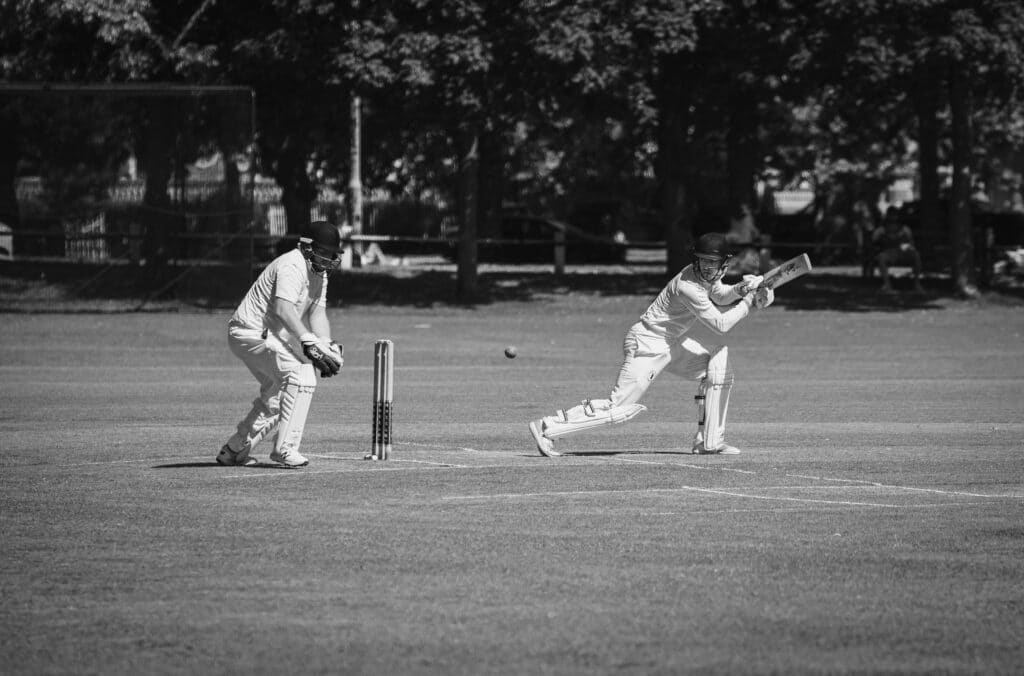Can a physiotherapist help with plantar fasciitis?
What we’ll cover
- Key Insights
- What is plantar fascia?
- Causes of Plantar Fasciitis
- Common Symptoms of Plantar Fasciitis
- Treatment Options for Plantar Fasciitis
- Exercises for Plantar Fasciitis Recommended by Physiotherapists
- Preventing Plantar Fasciitis
- FAQs
- Should I stop exercising with plantar fasciitis?
- How long does plantar fasciitis take to heal?
- What shoes should I wear for plantar fasciitis?
- Can plantar fasciitis come back after treatment?
- When should I see a doctor for plantar fasciitis?
Can a physiotherapist help with plantar fasciitis?
Plantar fasciitis (fasciopathy) is a common source of heel pain. Common symptoms include pain and stiffness often first thing in the morning or with the first few steps following after sitting down. These symptoms often appear to warm up or settle as you continue to walk or run.
Physiotherapist Laura Scott identifies the best methods of treating and preventing plantar fasciitis.
Key Insights
- Plantar fasciitis is a common yet painful condition that can significantly impact your daily activities if left untreated.
- By understanding the role of the plantar fascia and recognizing the causes, symptoms, and treatment options, you can take proactive steps to manage the condition effectively.
- Whether through simple lifestyle adjustments, supportive footwear, or targeted exercises, addressing plantar fasciitis early can help alleviate pain and prevent long-term damage.
- With proper care and attention, it is possible to regain full mobility and enjoy pain-free movement, allowing you to get back to your normal routine.
What is plantar fascia?
The plantar fascia is a thick band of fibrous tissue that attaches from the heel and extends to the base of your toes. It acts to support the arch of your foot and shock absorb during walking and running.
Causes of Plantar Fasciitis
Plantar fasciitis occurs with irritation or inflammation of the plantar fascia. There are a range of causes that can contribute to the development of this condition.
- Overuse: Athletes, especially runners, or individuals who stand for long periods are at higher risk due to the constant stress placed on their feet.
- Foot Structure: People with flat feet, high arches, or abnormal gait patterns may place extra strain on the plantar fascia.
- Obesity: Carrying excess body weight adds pressure to the plantar fascia, increasing the likelihood of inflammation.
- Inappropriate Footwear: Wearing shoes with poor arch support or inadequate cushioning can exacerbate the condition.
- Age: Plantar fasciitis is more common in middle-aged adults, though it can affect people of all ages.
Common Symptoms of Plantar Fasciitis
The primary symptom of plantar fasciitis is a sharp, stabbing pain in the heel or arch of the foot, which is most noticeable when taking the first steps in the morning. This morning pain is due to the tightening of the plantar fascia during sleep. As you walk, the pain typically decreases, but it can return after long periods of standing or after exercise.
Other signs and symptoms include:
- Pain after long periods of inactivity: Pain might flare up after sitting for an extended period and then standing up.
- Pain after exercise, not during: Unlike other injuries, plantar fasciitis pain is more likely to occur after physical activity rather than during the workout.
- Tenderness in the heel: The bottom of the heel may feel sore or tender to the touch.
- Difficulty walking or standing: Severe cases of plantar fasciitis may cause difficulty walking, especially on hard surfaces.
Ignoring these symptoms can lead to chronic pain, affecting your quality of life and making it difficult to carry out daily tasks. Early diagnosis and treatment can prevent long-term damage to the plantar fascia.
Treatment Options for Plantar Fasciitis
The first stage of treatment is to reduce symptoms such as pain and stiffness as quickly as possible. Using an ice pack is a simple and effective method to reduce pain. Rolling a frozen drink bottle can be an great way to ice whilst gently massaging your plantar fascia. In some cases, anti-inflammatory medication can be used to assist with the pain.
Techniques that your physiotherapist may utilise to reduce pain include joint mobilisations for stiff joints, massage and dry needling. Depending on the cause of your plantar fasciitis, taping, braces or heel cups can be utilised to support and protect the plantar fascia.
Other several ways to manage and alleviate the symptoms of plantar fasciitis.
- Rest: Reducing activities that strain your feet can help the plantar fascia heal.
- Stretching and Strengthening Exercises: Specific exercises to stretch the Achilles tendon, calf muscles, and plantar fascia can alleviate tension.
- Footwear Adjustments: Wearing supportive shoes with good arch support and shock absorption can minimise pressure on the fascia.
- Orthotic Inserts: Custom or over-the-counter inserts can provide additional support for the arch.
- Physical Therapy: Targeted treatments by a therapist can improve flexibility and strength.
- Anti-inflammatory Medications: Over-the-counter pain relievers like ibuprofen can reduce inflammation and discomfort.
In severe cases, more advanced interventions such as corticosteroid injections, shockwave therapy, or surgery may be considered if conservative treatments fail to provide relief.
Exercises for Plantar Fasciitis Recommended by Physiotherapists
Flexibility exercises for the calf can also be beneficial. This includes using a foam roller or calf stretches. Try holding the stretches below for at least 15 sec, 4 -5 x day.

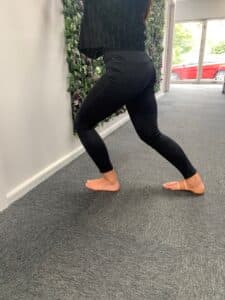
The second stage of rehabilitation is rehabilitate and progressively load the plantar fascia through gradually loading and progressives exercises. An exercise that is specifically used to load the plantar fascia includes a heel raise with an elevated big toe. Elevating the big toe onto a towel or dowel places more load specifically through the plantar fascia. This exercise can be commenced using both feet before progressively moving to the affected leg.
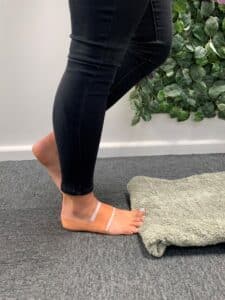
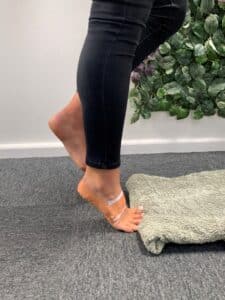
Your physiotherapist will also address other factors which may be contributing or causing plantar fasciitis. Commonly these can include decreased joint flexibility through the big toe or ankle, poor footwear and reduced muscular strength or endurance.
Preventing Plantar Fasciitis
The best way to avoid plantar fasciitis is by taking proactive steps to reduce the strain on your feet. Here are a few tips to help prevent the condition.
- Wear supportive shoes: Always wear shoes that provide good arch support and cushioning, particularly during physical activities.
- Maintain a healthy weight: Keeping your body weight in check will reduce pressure on your feet.
- Stretch regularly: Incorporate foot, ankle, and calf stretches into your daily routine, especially if you’re physically active.
- Avoid walking barefoot on hard surfaces: Walking barefoot on hard floors can put unnecessary stress on your plantar fascia.
- Alternate physical activities: Mix low-impact exercises like swimming or cycling with higher-impact activities to give your feet a break.
FAQs
Should I stop exercising with plantar fasciitis?
Continuing to exercise is important in the management of plantar fasciitis. Just like management of tendon injuries, we know that overloading and underloading can actually increase symptoms and the time it takes for healing. A good rule of thumb is that exercise can continue as long as morning pain and stiffness does not increase the following day. u003cbru003eConsider modifying the distance or speed that you have been walking or running to ensure that pain does not increase several hours following exercise or the following day. In some cases, cross training exercises such as cycling or the elliptical machine are good methods to continue exercise.
How long does plantar fasciitis take to heal?
With proper treatment, plantar fasciitis typically heals within a few months, but recovery time can vary. Some cases may take longer, especially if the condition is severe or if conservative treatments are not followed.
What shoes should I wear for plantar fasciitis?
Shoes with good arch support, cushioning, and a slight heel can help reduce strain on the plantar fascia. Avoid flat shoes, high heels, or shoes with inadequate support.
Can plantar fasciitis come back after treatment?
Yes, plantar fasciitis can recur if the underlying causes, such as poor footwear or overuse, are not addressed. Regular stretching, supportive shoes, and maintaining a healthy weight can help prevent future flare-ups.
When should I see a doctor for plantar fasciitis?
You should see a doctor if your heel pain persists for several weeks, worsens over time, or if you are unable to walk comfortably despite trying conservative treatments like rest and ice.
Your physiotherapist is well placed to assist in the management of plantar fasciitis. If you are experiencing foot or heel pain, contact our team or book online.
